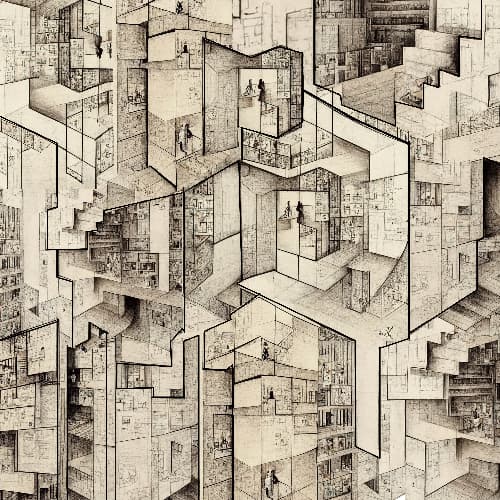

Produce - Exchange - Exhibit
By: Hana Čičević and Gabriela Villalobos Answering urbanistic questions of crucial importance demands a reflection on living experience in a metropolis of the past. New York City testifies that the metropolis of today is built upon the metropolis of yesterday. Perpetual change is the binding element of distinct points in time that serves as an encouragement to study the mistakes and successes of past urbanistic endeavors. Produce – Exchange – Exhibit is a project located in New York City Penn Station Area compresses an urban scale of the city into a single neighborhood. A modern metropolis is built upon the perpetual mode of constant exchange that enables its inhabitants to adopt new ways of thinking. The proposed exchange hub is based on an idea of honoring this notion through the architectural layering of various sub-programmatic concepts. The ground level market is the embodiment of the Exchange as it serves for the sale of physical goods. As the market is flexible, it has the potential to be transformed to host seasonal festivals to embody the notion of cultural exchange. The exchange of skills and knowledge is an indirect sub-programmatic concept, and spaces for such exchange are permeated throughout the two underground levels of the market. Produce and Exhibit are interconnected programmatic units that are distributed throughout the two remaining sites. Production is the elementary incentive that is necessary for any metropolis as it enables a continuous supply of fresh ideas. The design proposes spaces for both the literal manufacture of goods and arts, as well as for the production of knowledge and skills through education. Exhibition (e.g. theaters, galleries) is used as a medium to translate the produced skills into the language understandable by a wider audience. Tower elements are introduced into both of these sites to satisfy the need for housing and offices in the area. The verticality of these modular programs is interrupted by moments of suspension that serve to the overall idea of Produce –Exchange – Exhibit. Produce – Exchange – Exhibit is a project located in New York City Penn Station Area compresses an urban scale of the city into a single neighborhood.

AI Architecture 2022 - Maze of Memories
Authors: Daniel Abraham Gandica and Hana Čičević The key to this place was obtained through imagination. Before me laid a dimension of space and time. In their vertical crypts, the memories and dreams of men long gone begged to ripple the sands of time once again by telling the glories and tragedies of heroes past. Summits of knowledge along with deep pits of human fears lay bare for the beholding eye to cast judgment and admiration—the whole human experience, condensed and recorded in ink and paper. Tomes drag me to impossible echoes from eons lost to the unforgiving and apathetic passage of time. And in this journey, the visions of the master masons and skillful artists suddenly became mine. I saw spaces between spaces, and in those spaces between spaces, I felt the desires of all the people. The desire to live, to create, to thrive, to feel life's breath and propagate it to all corners of the Earth. A quickening within me shatters the veil of reality, along with my perception of time. Time. How much time have I spent in this forsaken palace of remembrances? The realization that I cannot answer my own questions filled me with terror. I ran, only to get lost in this infinite maze, a product of my own mind, never to be seen again, unable to ever live a life worthy of being recorded along the recorded memories than now become my eternal prison… *Images produced with MidJourney and Photoshop

Organic Factories
Authors: Daniel Abraham Gandica Hana Čičević This architectural project explores a future in which plants are manufactured in factories controlled by Artificial Intelligence, as opposed to being grown from seeds. The project focuses on the concept of an almost post-human world, in which plants have taken over three abandoned factories located in different climate zones, and repurposed them for their own use. The design of the factories is an exploration of how plants could inhabit such spaces and how they could be adapted for their needs. The project also looks at how the AI could be programmed to control the environment of the factory, including temperature, light and water levels. The factories and the plants create a symbiotic relationship where nature and architecture not only co-exist, but rather co-depend.

Organic Fragmentation: Blending the Artificial and the Organic
By: Daniel Abraham Gandica and Hana Čičević Organic Fragmentation: Blending the Artificial and the Organic explores the symbiotic relationship between nature and architecture and how the two merge into abstract architectural forms. The series of explorations aim to examine different ways in which architecture and nature can co-exist and influence each other. The elements of nature were used to break up the forms of the architecture into pieces, creating unique and dynamic shapes that mimic the irregularity of nature. The results are abstract sculpture-like structures. This project demonstrated how architecture could coexist with nature and served as inspiration for future projects seeking to find a balance between the built environment and the natural world.